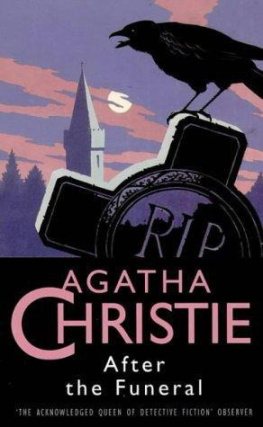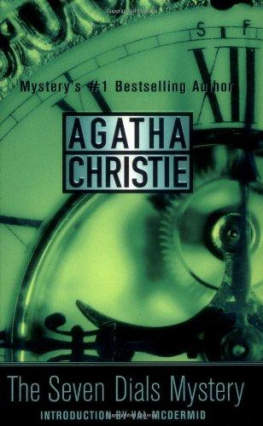Agatha Christie - The Floating Admiral
Here you can read online Agatha Christie - The Floating Admiral full text of the book (entire story) in english for free. Download pdf and epub, get meaning, cover and reviews about this ebook. year: 2011, publisher: HarperCollins Publishers, genre: Detective and thriller. Description of the work, (preface) as well as reviews are available. Best literature library LitArk.com created for fans of good reading and offers a wide selection of genres:
Romance novel
Science fiction
Adventure
Detective
Science
History
Home and family
Prose
Art
Politics
Computer
Non-fiction
Religion
Business
Children
Humor
Choose a favorite category and find really read worthwhile books. Enjoy immersion in the world of imagination, feel the emotions of the characters or learn something new for yourself, make an fascinating discovery.
- Book:The Floating Admiral
- Author:
- Publisher:HarperCollins Publishers
- Genre:
- Year:2011
- Rating:3 / 5
- Favourites:Add to favourites
- Your mark:
- 60
- 1
- 2
- 3
- 4
- 5
The Floating Admiral: summary, description and annotation
We offer to read an annotation, description, summary or preface (depends on what the author of the book "The Floating Admiral" wrote himself). If you haven't found the necessary information about the book — write in the comments, we will try to find it.
The Floating Admiral — read online for free the complete book (whole text) full work
Below is the text of the book, divided by pages. System saving the place of the last page read, allows you to conveniently read the book "The Floating Admiral" online for free, without having to search again every time where you left off. Put a bookmark, and you can go to the page where you finished reading at any time.
Font size:
Interval:
Bookmark:

The Floating Admiral
By Certain Members of the Detection Club
G. K. Chesterton
Canon Victor L. Whitechurch
G. D. H. and M. Cole
Henry Wade
Agatha Christie
John Rhode
Milward Kennedy
Dorothy L. Sayers
Ronald A. Knox
Freeman Wills Crofts
Edgar Jepson
Clemence Dane
Anthony Berkley

Contents
By Simon Brett
By Dorothy L. Sayers
The Three Pipe Dreams
By G. K. Chesterton
Corpse Ahoy!
By Canon Victor L. Whitechurch
Breaking the News
By G. D. H. and M. Cole
Bright thoughts on Tides
By Henry Wade
Mainly Conversation
By Agatha Christie
Inspector Rudge begins to form a Theory
By John Rhode
Inspector Rudge Thinks Better of It
By Milward Kennedy
Shocks for the Inspector
By Dorothy L. Sayers
Thirty-Nine Articles of Doubt
By Ronald A. Knox
The Visitor in the Night
By Freeman Wills Crofts
The Bathroom Basin
By Edgar Jepson
At the Vicarage
By Clemence Dane
Clearing up the Mess
By Anthony Berkeley
Solutions
Notes on Mooring of Boat

By Simon Brett
PRESIDENT OF THE DETECTION CLUB 2001
IT is appropriate that the origins of the Detection Club are shrouded in mystery. No official archives for the organisation have ever been kept and so its history has to be pieced together from the memoirs, correspondence, hints and recollections of its members. One reason for this incomplete record may be that the Club originally prided itself on being a kind of secret society, with rituals known only to its initiates. In the days of the internet, however, such a level of security is impossible. Indeed, an extract from the Detection Clubs most secret rite, the Initiation of New Members, is readily accessible on Wikipedia.
So the Clubs history is, at the best, conjectural. One authority declares that it was founded in 1932 with 26 members, but this assertion is somewhat weakened by the fact that a letter was published in the Times Literary Supplement in 1930 and signed by members of the Detection Club. And the serials The Scoop and Behind the Screen appeared in The Listener respectively in 1930 and 1931. They were written by multiple authors, including Agatha Christie, Dorothy L. Sayers, E. C. Bentley and Anthony Berkeley, under the name of the Detection Club, as was this work, The Floating Admiral , whose copyright notice on the first edition reads: The Detection Club 1931.
So a more likely prehistory of the Club was that round about 1928 Anthony Berkeley Cox (who only used his first two names on his books) and other detective writers started to meet for informal dinners, which then became more established into the rituals of a Club. According to some sources, G. K. Chesterton was appointed the first Presidentthough sometimes referred to as Leaderin 1930. Mind you, other authorities say that he didnt take over the Presidential mantle until 1932. Even the Detection Club itself is inconsistent about the date. On its headed notepaper is stated that Chestertons reign began in 1932, whereas in the List of Members it says 1930. So you can really take your pick.
What is certain, however, is that, on 11 March 1932 the Constitution and Rules of the Detection Club were adopted. The opening section of this document reads: The Detection Club is instituted for the association of writers of detective-novels and for promoting and continuing a mutual interest and fellowship between them. Members had to fulfil the following condition: That he or she has written at least two detective-novels of admitted merit or (in exceptional cases) one such novel; it being understood that the term detective-novel does not include adventure-stories or thrillers or stories in which the detection is not the main interest, and that it is a demerit in a detective-novel if the author does not play fair by the reader.
In this 1932 Constitution, the Ordinary Meetings of the Club should be not fewer than four in the year, so things havent changed that much. In 2010and for many years before thatthe Detection Club met three times.
What has changed is the criterion of admissibility for potential candidates. With the great spread of crime fictions range, the qualification has been extended way beyond the traditional whodunit (which is just as well, because very few people nowadays write traditional whodunits). The current membership certainly includes writers of adventure-stories or thrillers or stories in which the detection is not the main interest, as well as practitioners of the historical, legal, forensic, psychopathological and other developing subgenres. Crime fiction is a much broader church now than it was in the 1920s and 1930s, and the Detection Club reflects that.
Some would argue that contemporary mysteries are much more varied and frequently better written than the offerings of that so-called Golden Age. They are certainly more psychologically credible than many of the works produced at that time. They are also more serious, sometimes even to the point of taking themselves too seriously. In crime fiction, noir is the new black.
Most of these differences could be seen as improvements, but the one thing that has been lost with the passage of time is the sense of fun that used to be associated with crime fiction. In her introduction to The Floating Admiral , Dorothy L. Sayers description of the collaborative exercise is: the detection game as played out on paper by certain members of the Detection Club among themselves. And later she writes: Whether the game thus played for our own amusement will succeed in amusing other people also is for the reader to judge. The fact that the book is being reissued yet again suggests that there are still plenty of readers out there willing to be amused by the game.
A lot of Golden Age crime novels were games. A murder mystery was an intellectual challenge rather on the same level as a crosswordand its interesting that the two forms of entertainment both developed around the same time. In the days before television, in the days of country house parties, such games were very popular. Collections of crime puzzleslike F. Tennyson Jesses The Baffle Book, A Parlour Game of Mystery and Detection sold in large numbers. It was indeed the age of the parlour game which hardly exists nowadays. People dont have parlour games. Very few of them even have parlours.
But it is in the spirit of a parlour game that The Floating Admiral should be approached. The idea of a serious (should I use that awful word literary?) novel written by a relay of authors is incongruous. For a light-hearted work of crime fiction, though, the concept is fun, and I think its clear that the writers involved in The Floating Admiral enjoyed the intellectual challenge that faced them.
I have been involved in a couple of collaborative ventures of this kind and I very quickly discovered that the best job to get is that of the person who starts the story. In the first chapter you can sprinkle clues and inconsistencies with reckless abandon, secure in the knowledge that it wont be you who has to tie up all the loose ends later. As a logical consequence of this, the worst job is writing the final chapter, pulling together all the threads of the story to produce a credible solution to the mystery. The temptation to begin that final chapter with the words But it was all a dream is strong.
Next pageFont size:
Interval:
Bookmark:
Similar books «The Floating Admiral»
Look at similar books to The Floating Admiral. We have selected literature similar in name and meaning in the hope of providing readers with more options to find new, interesting, not yet read works.
Discussion, reviews of the book The Floating Admiral and just readers' own opinions. Leave your comments, write what you think about the work, its meaning or the main characters. Specify what exactly you liked and what you didn't like, and why you think so.













![Agatha Christie [Agatha Christie] - Problem at Pollensa Bay](/uploads/posts/book/140367/thumbs/agatha-christie-agatha-christie-problem-at.jpg)




